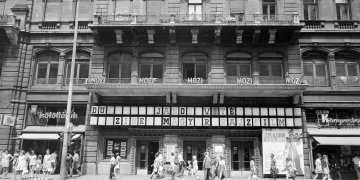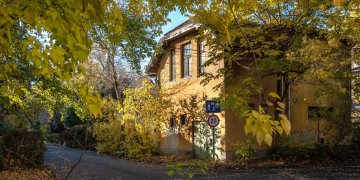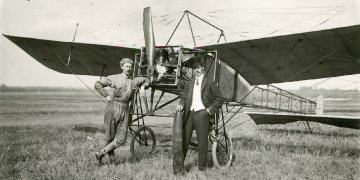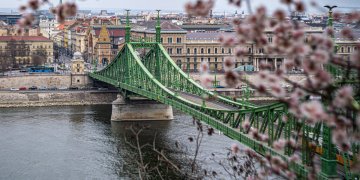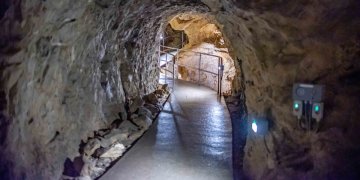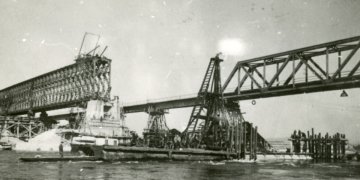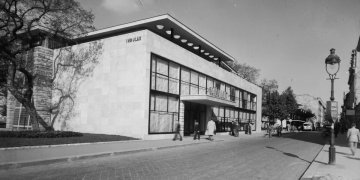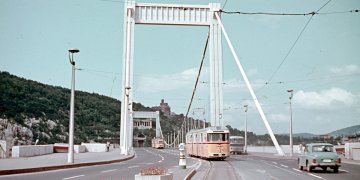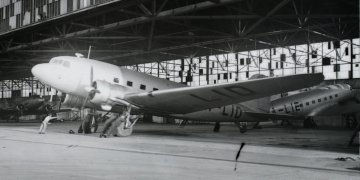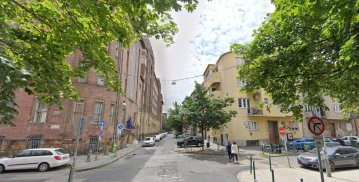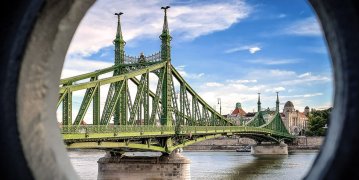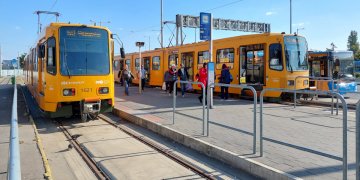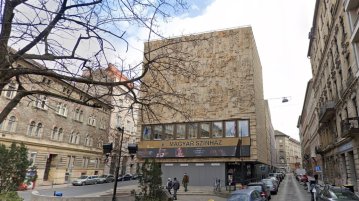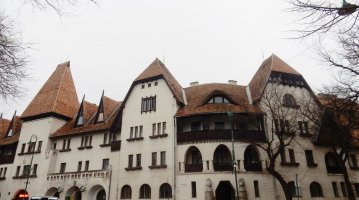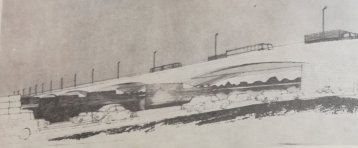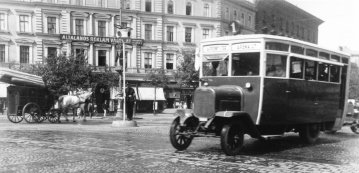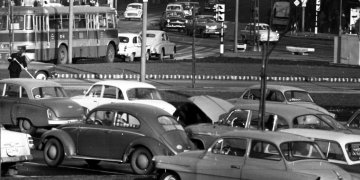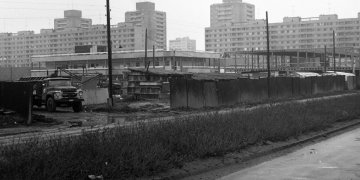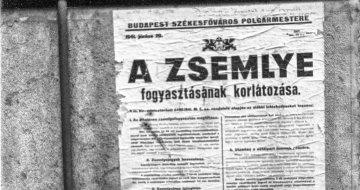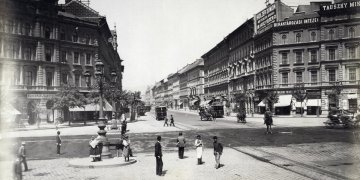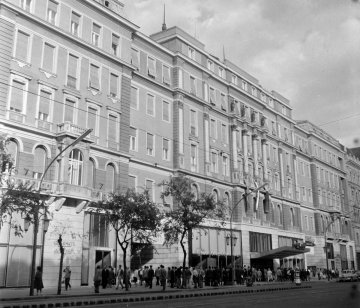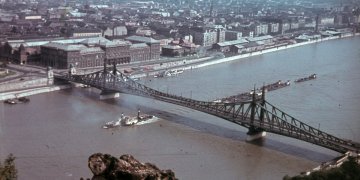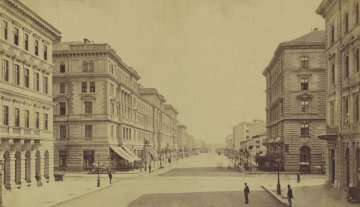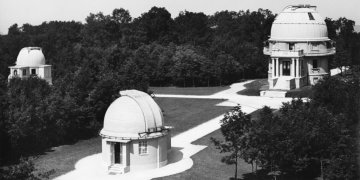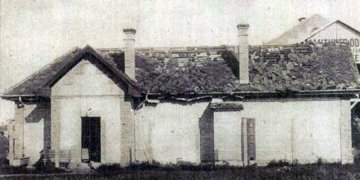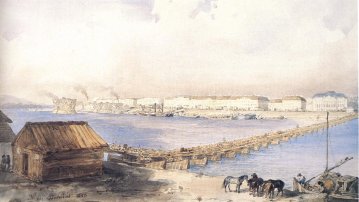Csaba Domonkos
Cikkek
The Fórum film theatre, the forerunner of Puskin cinema, opened 95 years ago
November 25, 2021 at 10:00 AM
The building, which houses the Puskin Cinema and was built in 1895 according to the plans of Czigler Győző, has had a cinema in it since 1926, before which the Magyar Világ Café was located on the ground floor of the building. An audio film was first screened in Hungary at the former Fórum film theatre in 1929, although this was almost thwarted by a patent lawsuit.
The artists' colony on Százados Road was built on the outskirts of the city 110 years ago, today it is an integral part of Józsefváros
November 15, 2021 at 1:00 PM
A special and closed world bordered by a fence where artists live and create. That's how it has been for110 years. With the support of Mayor István Bárczy, the country's first artists' colony was built on Százados Road in 1911 from the budget of the capital, with fifteen one-storey houses and 28 studios. From the beginning, renowned artists created here, including Ferenc Medgyessy, Zsigmond Kisfaludi Strobl, Bertalan Pór, Dezső Czigány. The area, which was still a suburb at the time of its handover, is now an integral part of Józsefváros.
The first Hungarian flew over Budapest 110 years ago
November 12, 2021 at 9:00 AM
One of the most colourful personalities in the heroic age of aviation was Guido Prodam. The adventurous pilot learned to fly in Rákosmező, and he was the first Hungarian to fly over the Budapest downtown 110 years ago. During his journey, he flew along the Danube, he also flew above the Chain Bridge, the Buda Castle and the Technical University.
Without whom the Liberty Bridge would not be the same: Virgil Nagy, the master builder of metal, died a hundred years ago
November 8, 2021 at 6:30 PM
Virgil Nagy, who designed the structures that fundamentally define the view of Budapest, passed away 100 years ago, the architectural design of the Liberty Bridge and the aesthetic appearance of the old Elizabeth Bridg , which was blown up in 1945, are his works.
"Budapest should be made a metropolis" - 150 years ago, the large-scale constructions in the capital were announced
November 4, 2021 at 10:30 AM
The transformation of the Hungarian capital into a metropolis was formulated before the unification of Pest and Buda, when in 1871 a tender was issued for the preparation of a regulatory plan that would provide a framework for the planned large-scale constructions. The tender, which closed 150 years ago, received a number of proposals that contributed to the development of the currently known structure and cityscape of the capital.
Miracle under Buda - The Szemlő-hegyi Cave can be visited for 35 years
November 1, 2021 at 2:00 PM
Although the Szemlő-hegyi Cave has been discovered for more than 90 years, it has only been open to the public for 35 years. This is one of the most beautiful and interesting underground attractions in the capital, which is a great recognition, as there are several cave specialities below Budapest.
Intended to be temporary, the structure of the Connecting Railway Bridge built after the war served Budapest until 2008
October 29, 2021 at 10:00 AM
At the end of World War II, a permanent railway bridge over the Danube was rebuilt at record speed. One and a half years after the weapons were silenced in the country, and exactly 22 months after the bridge was blown up, the semi-permanent structure of the Connecting Railway Bridge was already standing, weighing half as much as the Chain Bridge which is much longer than this. Although it was demolished a few years later from its original location, it moved to Újpest, where it served traffic until recently.
The Erzsébet Square bus terminus in the middle of the city centre had been closed for 20 years
October 19, 2021 at 10:30 AM
The Erzsébet Square bus station has not departed and accepted buses for twenty years now. For much of the 20th century, it was still natural for buses to depart from central spaces that were easily accessible to all, but due to changes in urban development considerations, bus stations were pretty slowly pushed out of the inner city core. The Erzsébet Square bus station in the 5th District was also closed down.
The roaring Bengali - The first articulated trams were not a success in Budapest
October 17, 2021 at 9:00 AM
By the end of the 1950s, the existing trams in Budapest proved to be increasingly too small, so a new, more accommodating, articulated tram was built by Hungarian engineers, the Bengali. The recipe was simple, the type was spacious and shapely, yet the first articulated trams that appeared in Budapest were not clearly successful.
The first post-war domestic flight departed from Budapest 75 years ago
October 15, 2021 at 9:00 AM
Reconstruction after World War II also extended to transport networks. On the one hand, the railway also suffered from the war, and on the other hand, the existing capacities were tied up in the reconstruction, so part of the passenger transport was solved by planes. Domestic flights were launched on 15 October 1946 by Malév's predecessor, the Maszovlet company, and the first two planes could travel from Budapest to Debrecen and Szombathely.
Gyorskocsi Street in Buda preserves the name of a special means of transport
October 13, 2021 at 10:00 AM
Gyorskocsi Street in Buda preserves the history of the means of transport used in the 18th-19th century, before the spread of the railway, which made it possible to get from Buda to Vienna and back in the shortest time. But what was that particular gyorskocsi [diligence or stagecoach] like, who travelled by it, and how long did the trip take? You can read about that here.
Miracle in green: Liberty Bridge, one of the most beautiful ornaments of Budapest, is 125 years old
October 4, 2021 at 9:00 AM
Liberty Bridge is 125 years old. Budapest's shortest Danube bridge hides many interesting things. At the time of its handover, in the year of the millennium, Franz Joseph hammered the last silver rivet in, its colour has been blue and gray in addition to green, they wanted to demolish it once, and at its renovation before the regime change they placed back the historical Hungarian coat of arms cunningly.
Trams from Hanover have been operating in Budapest for 20 years
October 2, 2021 at 4:00 PM
After a long time in the rich tram park of Budapest, the first vehicles manufactured in Western Europe were the trams from Hanover with their characteristic opening staircases, which were put into traffic for the first time on 3 October 2001.
The National Theatre operated in Hevesi Sándor Square for 34 years
October 1, 2021 at 12:30 PM
When the old building of the National Theatre on Blaha Lujza Square was blown up on 15 March 1965, no one would have thought the institution would operate in a temporary location for three and a half decades. The National Theatre held its opening performance on 1 October 1966, in the building of the former Hungarian Theatre on Hevesi Sándor Square, and until 2000, it was the home of the company.
Wekerletelep in Kispest also preserves the memory of the prime minister who passed away a hundred years ago
September 26, 2021 at 9:30 AM
Wekerletelep with its special atmosphere is located in Kispest. Its smaller and larger houses form this fairytale-looking part of the city in a uniform style, arranged in streets that are inexplicable for an outsider, but are in a regular order. Its creation was initiated by Sándor Wekerle, one of the most prominent Hungarian prime ministers, who passed away a hundred years ago.
Fifty years ago, a highway bridge was designed on the edge of the inner city
September 25, 2021 at 10:00 AM
Increasing car traffic has been a problem in the capital for decades. It even come up in the early 1970s that a a huge highway bridge should be built on the Danube in the Lágymányos area. If that planned bridge had been realized, we would be living in a different Budapest today.
A hundred years ago, bus traffic in Budapest resumed
September 23, 2021 at 10:00 AM
In Budapest, after the First World War, bus traffic did not start again until 1921. One hundred years ago, electric vehicles first transported passangers between the Aréna, i.e. today’s Dózsa György Road and Apponyi Square, today's Ferenciek Square. Although many considered the racing vehicles to be a luxury, in the end bus transport gained a raison d’être in the capital.
The first steam mill in Pest started significant industrial development - the József Rolling Mill started operating 180 years ago
September 22, 2021 at 9:00 AM
Today it is difficult to imagine, but once the first steam mill in Pest was built and operated in Lipótváros, in the area bordered by today's Bálint Balassi - Béla Stollár - Falk Miksa and Balaton Streets, which started operating on 22 September 1841. However, the József Hengermalom [Rolling Mill] was more than a simple mill. The modern plant established on the initiative of István Széchenyi was not financially successful, but as a result the milling industry and the machine industry also started to develop significantly. Pest in the second half of the 19th century became a major power of the milling industry.
Smoggy roads, blackening house walls - decreasing air pollution in Budapest was decided 45 years ago
September 15, 2021 at 3:00 PM
The air in Budapest was already so bad in the mid-1970s that the problem forced the authorities to take action. The Budapest Socialist Council therefore designated nine areas in the autumn of 1976 where improving air quality was a priority.
A new department store can replace the more than 40-year-old service house in Kelenföld
September 13, 2021 at 9:00 AM
In the early 1970s, people living in a housing estate in Kelenföld often complained about the lack of services, and in the second half of the decade, a service house was built to remedy this. It had almost everything needed on the two levels. The now obsolete building on the corner of Tétényi Road - Etele Road is now being sold by the municipalities of the capital and the 11th District, and a service house would be built again on the site.
Bread and flour stamps were introduced 80 years ago in Budapest
September 9, 2021 at 10:00 AM
Although Budapest was seemingly peaceful in 1941, the effects of the war were already being felt. Meat consumption and the use of cars were restricted. Sugar and fat could only be bought on ration stamps from 1940, and 80 years ago, flour and bread stamps were introduced. This restriction affected Budapest and the surrounding area in September 1941.
The Outer Ring Road was inaugurated 125 years ago - Budapest's main road was opened on Hungary's millennium
September 4, 2021 at 10:00 AM
Today, Outer Ring Road is one of the busiest roads in Budapest, lined with beautiful residential houses. Its construction lasted for 25 years, to open it, houses had to be demolished, a railway station had to be moved away, an area had to be filled, but finally, 125 years ago, on 31 August 1896, the Budapest Public Works Council could officially hand it over to the Budapest community.
The Ikarus 66 was an iconic piece of Hungarian bus production – Now we can see it renovated in the Museum of Transport
August 28, 2021 at 12:00 PM
A special bus was presented to the general public yesterday by the Museum of Transport: one of the last ten Ikarus 66 models produced. The vehicle was exhibited after several years of restoration in Kőbánya, in the Diesel Hall of the former Northern Locomotive Workshop. Budapest once expected these Ikarus buses to make transportation faster and more convenient, but passengers in the capital found them uncomfortable.
The luxury hotel was designed for tourists from the West - the Royal reopened 60 years ago
August 25, 2021 at 1:00 PM
The former legendary hotels of Budapest were almost completely destroyed in the Second World War and in the 1950s, and in the Rákosi era, no money was spent on building luxury hotels in the country, as there was no solvent demand for it. The situation changed after the defeat of the revolution and war of independence of 1956: tourists from the West and the currency they spent here became important to the country’s new leadership. Large-scale hotel developments began, among them one of the first was rebuilding the former luxury hotel, Royal, which reopened in August 1961.
It was rebuilt, but its decoration and name were changed - the Liberty Bridge was handed over 75 years ago
August 23, 2021 at 9:30 AM
At the end of the spectacular fireworks held in Budapest on the occasion of the founding of the state, glowing Greek fires were started on the bridges, including the Liberty Bridge. At that moment, surely few thought it was the first bridge to be rebuilt after the devastation of World War II and handed over to traffic on 20 August 1946.
Inspired by the boulevards of Paris - in 1876 the present-day Andrássy Avenue was handed over
August 21, 2021 at 10:00 AM
The traffic between the inner city of Pest and the Városliget went through Király Street for a very long time. The narrow street was very crowded, as not only the normal traffic passed through here, but also those who wanted to go to the Városliget for a little refreshment. The Avenue [Sugárút in Hungarian], officially handed over 145 years ago, in 1876, today's Andrássy Avenue, along which lavish palaces were built in place of the one-storey houses, was made to aid this situation.
The sky over Budapest - the observatory was moved to Svábhegy because of Trianon
August 16, 2021 at 9:00 AM
The construction of the new Budapest Observatory began on Svábhegy a hundred years ago, which replaced the Ógyalla observatory lost with Trianon. Despite the initial difficulties, a European-level research center was set up in a few years near Normafa, where the skies of Budapest are still being viewed in the observatory's typical domed building.
The Adria Palace in the storm of history
August 15, 2021 at 3:00 PM
The book titled Hazának használj! Az Adria-palota története [Help the Homeland! The History of the Adria Palace] was recently published, which not only presents the history of the nearly 120-year-old building in Szabadság Square, which is currently under renovation, but also provides an insight into the lives of the former owners and celebrities who lived here.
A part of the city has become uninhabitable - We still do not know who blew up the Csepel munitions depot 95 years ago
August 14, 2021 at 9:30 AM
A large-scale explosion shook Csepel and the southern part of Budapest on 12 August 1926, at quarter to seven p.m. The disaster 95 years ago caused severe damage to houses in Csepel and Budafok: it broke the window panes, swept the tiles off the roofs. Fortunately, the explosion did not claim human lives, the blaze and sound of which could be seen and heard throughout Budapest.
Life before the Chain Bridge
August 2, 2021 at 9:00 AM
The pontoon bridge between Pest and Buda was built due to the visit of Archduke Albert Casimir and was closed, with a little exaggeration, due to the trip of Count István Széchenyi. The pontoon bridge between the two banks of the Danube was built 255 years ago and was demolished 171 years ago.

